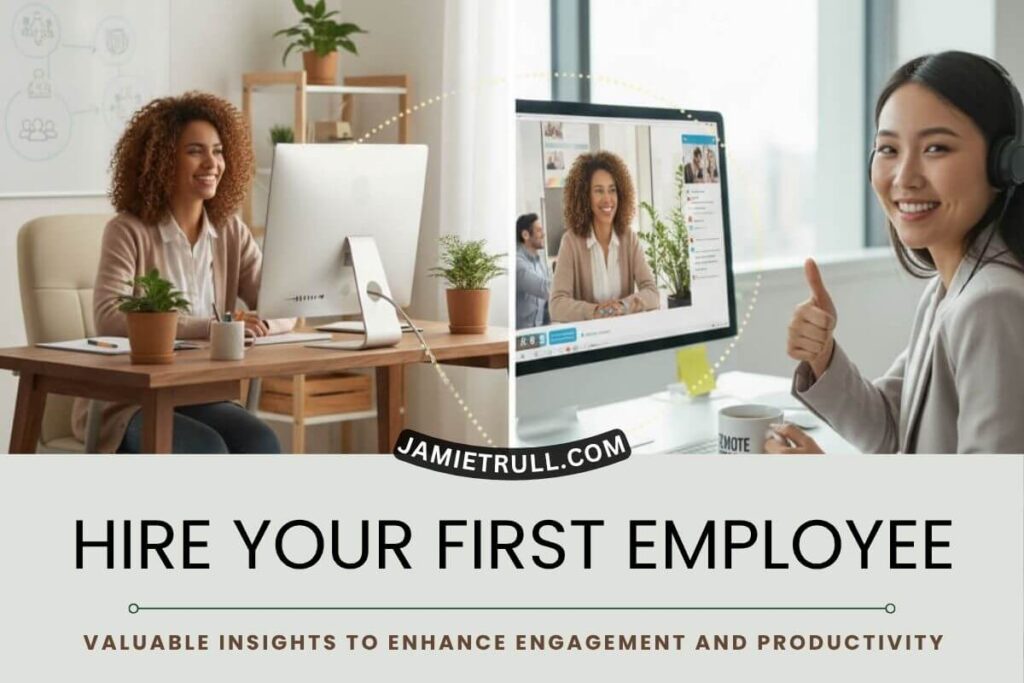
Need to know how to onboard a new employee?
🎉 Congratulations—this is a huge milestone for your business.
But let’s be honest—onboarding tasks can also feel overwhelming.
Between figuring out worker classification, filling out endless forms, and setting up payroll, you may be wondering: Am I doing this right?
As a CPA and financial educator, I’ve helped thousands of small business owners navigate the small business hiring process.
And I’m here to walk you step-by-step through how to onboard your first employee legally, confidently, and without losing sleep.
Step 1: Employee or Contractor? Know the Difference
Before you can move forward, you need to determine whether your new hire is an employee (W-2) or an independent contractor (1099).
Rule of thumb for the job description of your new hire’s role:
- If you direct how, when, and where they work, they’re likely an employee.
- If they run their own business, serve multiple clients, and invoice you, they’re more likely a contractor.
⚠️ Be careful here.
Misclassifying workers can lead to penalties from the IRS and state labor departments.
👉 Use this Worker Classification Tool from OnPay to double-check: onpay.com/tools/worker-classification-checker
Step 2: Get Legally Set Up to Hire For Your New Role
If you’ve determined your worker is an employee, it’s time to set up your business for compliance:
- Apply for an Employer Identification Number (EIN) through the IRS (it’s free on their website).
- Check your state’s workers’ compensation laws (some require coverage even for your first employee’s role).
- Register with your state labor department and state revenue department so you can withhold and remit income taxes.
👉 If you need help organizing all of this, I recommend a good accounting tool.
Here are my favorite small business accounting software options.
Step 3: Choose Payroll Software (Don’t DIY!)
One of the biggest mistakes I see small business owners make is trying to run payroll manually.
Payroll is where compliance gets tricky. Think federal and state taxes, unemployment insurance, and quarterly filings.
That’s why I recommend OnPay payroll software for these routine tasks.
It’s designed specifically for small business owners. OnPay is easy to use, even if you’ve never hired before, and comes with live support for effective onboarding.
OnPay handles tax filings, new hire reporting, and even benefits administration for your new workers.
👉 Start your free trial and get a $100 referral bonus with my partner link: jamietrull.com/onpay
Step 4: Collect New Hire Paperwork

Every new hire must complete:
- Form W-4 for tax withholding
- Form I-9 to verify eligibility to work in the U.S.
- Direct deposit authorization (optional, but highly recommended)
With OnPay, you can send onboarding packets digitally and collect e-signatures—no more chasing down paperwork.
That’s why it’s on my list of must-have small business payroll tools.
Step 5: Add Them to Payroll
Once the paperwork is done, it’s time to officially add your employee into your payroll system:
- Input their personal information and pay rate
- Set your pay schedule (monthly, biweekly, etc.)
- Make sure you’ve registered with your state so you can report and remit taxes
👉 Not sure how to set the right pay for yourself as a business owner?
Check out my Savvy S Corp Owner Masterclass.
Step 6: Report Your New Hire
Most states require employers to report new hires within 10–20 days.
If you’re using payroll software like OnPay, this step is automatically handled for you. That’s one less compliance headache on your plate.
Step 7: Enhance The Employee Experience and Offer Benefits (Optional, But Smart)

Offering benefits like health insurance or retirement plans can be a game-changer for attracting and retaining employees. The tricky part? Staying compliant.
With OnPay, you can integrate benefits directly into your payroll system so deductions and reporting are handled automatically. They even have in-house benefits experts to guide you through the process.
Step 8: Make The Employee Onboarding Process Amazing 🎉
Compliance matters, but don’t forget about the human side of onboarding. Your employee’s first day should feel welcoming and organized.
- Send a welcome email ahead of time
- Host a team lunch or coffee chat
- Give them a small gift or welcome kit
A smooth onboarding experience builds loyalty, strengthens your culture, and sets the stage for long-term success.
Final Thoughts: Hiring Your First Employee Doesn’t Have to Be Scary

Yes, there are a lot of steps—classification, paperwork, payroll, reporting, benefits—but with the right tools, you can handle all of it. You don’t need to hire an expensive accountant or spend hours lost in government websites.
That’s exactly why I recommend OnPay payroll software—it streamlines onboarding, automates compliance, and makes the hiring process stress-free.
👉 Get started with OnPay today and claim your $100 referral bonus: jamietrull.com/onpay
Sponsored Disclaimer
This post is sponsored, but as always—we’re only sharing tools and resources we personally use and love. Your support helps us keep showing up and supporting our small (but mighty!) team.
Transcript: Please note that the following is a direct transcript and has not been fully edited for errors or omissions. It is a verbatim representation of the spoken words and may include colloquial language, grammatical errors, or other inconsistencies. We recommend cross-referencing with the original audio or video source for complete accuracy.
Employee Onboarding: How to Hire Your First Employee
Hiring your first employee is exciting, but it can also be a little terrifying. Are you doing everything legally? What are all these forms you need to fill out, and how do you actually pay them? Trust me, you’re not alone. And today I’m going to make things way easier.
Hi everyone, Jamie Trull here, your favorite CPA and financial educator. On this channel, I bring you all the topics that keep you informed, organized, and profitable in your business finances.
If you’re bringing someone onto your team for the very first time, you are in the right place. I’m going to walk you step by step through what you need to do to hire someone legally and make sure you don’t miss a step. Stick around to the end because I’ll share what I believe is the most important step in hiring a new employee—one many employers miss.
Step 1: Properly Classify Your New Hire
The onboarding process is completely different depending on whether you’re hiring a true employee (W-2) or an independent contractor (1099).
There is no such thing as a “1099 employee.” You can either be an independent contractor who gets a 1099 or an employee who gets a W-2. This classification determines your legal and tax obligations—and the penalties for getting it wrong can be severe.
Generally, if you control what, when, and how someone works, provide the tools, and set their hours, they’re an employee. If they serve multiple clients, invoice you, and work independently, they’re a contractor.
Some states, such as California, have stricter labor laws—most workers there will likely be employees. Always check your state’s rules or use a classification tool (like the one from OnPay linked below).
Step 2: Get Set Up Legally
If you’ve determined the person is a contractor, your main requirement is to send them a 1099 at year-end.
If you’re hiring an employee, you’ll need to take additional legal steps:
- Get an EIN (Employer Identification Number) for free from IRS.gov.
- Check your state’s workers’ compensation laws.
- Some states require coverage for your first employee.
- Others have thresholds (e.g., five employees).
- Register with your state’s labor and/or revenue department.
- Needed for payroll tax withholding and unemployment insurance.
- Requirements vary depending on whether your state has income tax.
Do this early—these registrations establish your legal foundation as an employer.
Step 3: Choose a Payroll System
Do not run payroll manually. Modern payroll systems handle forms, withholdings, filings, and payments automatically.
Look for one that can:
- Pay employees and handle direct deposits.
- Withhold and remit federal and state income taxes.
- File payroll tax forms (941s, W-2s, etc.).
- Track everything accurately.
A great small-business solution is OnPay—intuitive for beginners, helpful for onboarding, benefits, and compliance, plus it offers live support. Use Jamie’s referral link for a $100 bonus.

Step 4: Complete New Hire Forms
Once your employee accepts the job, it’s time to gather their new-hire paperwork.
Common forms include:
- W-4: Determines federal tax withholding.
- I-9: Confirms employment eligibility.
- Direct deposit authorization.
If you’re using payroll software like OnPay, many forms can be sent electronically for e-signature. You can also include internal documents (like an employee handbook) in their onboarding packet.
Step 5: Add the Employee to Payroll
Before running payroll, ensure you’ve registered with the correct state agencies.
Typically, you’ll need:
- An account with the Department of Revenue for income-tax withholding.
- An account with the Department of Labor (or Workforce Commission) for unemployment insurance.
Your payroll system will prompt you for these numbers and even remind you if you’re missing them. Once everything is set up, enter your employee’s details—name, address, SSN, pay rate, and pay schedule—and you’ll be ready to run your first payroll.
Step 6: Report Your New Hire to the State
Most states require employers to report new hires within 10–20 days. Payroll systems like OnPay will usually handle this automatically—one less thing for you to track.
Step 7: Assign Benefits (Optional but Recommended)
If you plan to offer benefits such as:
- Health insurance,
- Retirement plans, or
- Workers’ compensation coverage,
now’s the time to enroll your employee and ensure compliance.
Integrating your benefits and payroll under one system simplifies administration and keeps everything accurate and synced.
Step 8: Make the First Day Amazing ✨
This might be the most important step of all—creating an amazing first-day experience.
Don’t get lost in the paperwork. Focus on the human side of hiring:
- Send a welcome email.
- Organize a team lunch.
- Gift them some company swag 🎁.
When new employees feel welcomed and valued, it sets the tone for their entire employee experience and strengthens your company culture.
Best Practices for Employee Onboarding
- Use clear checklists for each stage (classification, legal setup, payroll, reporting).
- Keep forms organized digitally for easy access.
- Personalize the onboarding experience to make new hires feel part of the team.
- Revisit your onboarding process periodically to improve it as your company grows.
If you’d like to see a full walkthrough and review of the OnPay system or more videos about employee onboarding, hiring, and remote employees, subscribe to Jamie Trull’s channel for more tutorials.